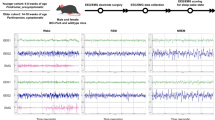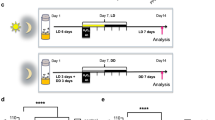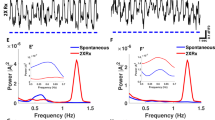Abstract
THERE is a wealth of data supporting a central role for the prion protein (PrP) in the neurodegenerative prion diseases of both humans and other species1, yet the normal function of PrP, which is expressed at the cell surface of neurons and glial cells2,3, is unknown. It has been speculated that neuropathology may be due to loss of normal function of PrP (ref. 4). Here we show that in mice devoid of PrP there is an alteration in both circadian activity rhythms and sleep patterns. To our knowledge, this is the first null mutation that has been shown to affect sleep regulation and our results indicate that the pathology of at least one of the inherited prion diseases, fatal familial insomnia5, where there is a profound alteration in sleep and the daily rhythms of many hormones6–10, may be related to the normal function of the prion protein.
This is a preview of subscription content, access via your institution
Access options
Subscribe to this journal
Receive 51 print issues and online access
$199.00 per year
only $3.90 per issue
Buy this article
- Purchase on Springer Link
- Instant access to full article PDF
Prices may be subject to local taxes which are calculated during checkout
Similar content being viewed by others
References
Prusiner, S. B. Science 252, 1515–1522 (1991).
Manson, J., McBride, P. & Hope, J. Neurodegeneration 1, 45–52 (1992).
Moser, M., Colello, R. J., Pott, U. & Oesch, B. Neuron 14, 509–517 (1995).
Collinge, J. et al. Nature 370, 295–297 (1994).
Lugaresi, E. et al. New Engl. J. Med. 315, 997–1003 (1986).
Medori, R. et al. New Engl. J. Med. 326, 444–449 (1992).
Montagna, P., Cortelli, P., Gambetti, P. & Lugaresi, E. Adv. Neuroimmun. 5, 13–21 (1995).
Portaluppi, F. et al. J. clin. Endocr. Metab. 78, 1075–1078 (1994).
Gambetti, P., Parchi, P., Peterson, R. B., Chen, S. G. & Lugaresi, E. Brain Path. 5, 43–51 (1995).
Reder, A. T. et al. Neurology 45, 1068–1075 (1995).
Manson, J. C. et al. Molec. Neurobiol. 8, 121–127 (1994).
Büeler, H. et al. Nature 356, 577–581 (1992).
Manson, J. C. et al. Neurodegeneration 4, 113–115 (1995).
Possidente, B. & Stephan, F. K. Behavl Genet. 18, 109–117 (1988).
Schwartz, W. J. & Zimmerman, P. J. Neurosci. 10, 3685–3694 (1990).
Fischer, M. et al. EMBO J. (in the press).
Yamada, N., Shimoda, K., Ohi, K., Takahashi, S. & Takahashi, K. Physiol. Behav. 42, 87–91 (1988).
Hotz Vitaterna, M. et al. Science 264, 719–725 (1994).
Bult, A., Hiestand, L., Van der Zee, E. A. & Lynch, C. Brain Res. Bull. 32, 623–627 (1993).
Valatx, J. L., Bugat, R. & Jouvet, M. Nature 238, 226–227 (1972).
Valatx, J. L. & Bugat, R. Brain Res. 69, 315–330 (1974).
Friedman, J. K. Physiol. Behav. 12, 169–175 (1974).
Borbély, A. A. In: Kryger M. H., Roth T., Dement W. C. (eds) Principles and Practice of Sleep Medicine 2nd edn, 309–320 (Saunders, Philadelphia, 1994).
Tobler, I. & Borbély, A. A. Electroenceph. Clin. Neurophysiol. 64, 74–76 (1986).
Westaway, D. & Prusiner, S. P. Nucleic Acids Res. 14, 2035–2044 (1986).
Deboer, T., Franken, P. & Tobler, I. J. Comp. Physiol. A. 174, 145–155 (1994).
Franken, P., Dijk, D. J., Tobler, I. & Borbély, A. A. Am. J. Physiol. 261, R198–208 (1991).
Deboer, T. & Tobler, I. Brain Res. 670, 153–156 (1995).
Author information
Authors and Affiliations
Rights and permissions
About this article
Cite this article
Tobler, I., Gaus, S., Deboer, T. et al. Altered circadian activity rhythms and sleep in mice devoid of prion protein. Nature 380, 639–642 (1996). https://doi.org/10.1038/380639a0
Received:
Accepted:
Issue Date:
DOI: https://doi.org/10.1038/380639a0
This article is cited by
-
Extracellular vesicles with diagnostic and therapeutic potential for prion diseases
Cell and Tissue Research (2023)
-
Mechanisms of prion-induced toxicity
Cell and Tissue Research (2023)
-
Intracellular ATP levels in mouse cortical excitatory neurons varies with sleep–wake states
Communications Biology (2020)
-
Structural and mechanistic aspects influencing the ADAM10-mediated shedding of the prion protein
Molecular Neurodegeneration (2018)
-
The function of the cellular prion protein in health and disease
Acta Neuropathologica (2018)
Comments
By submitting a comment you agree to abide by our Terms and Community Guidelines. If you find something abusive or that does not comply with our terms or guidelines please flag it as inappropriate.



